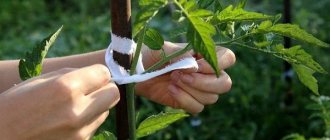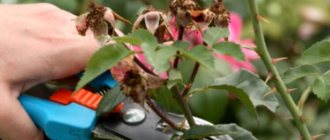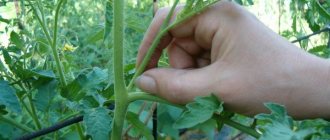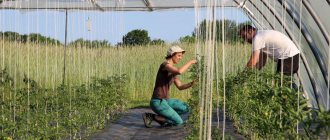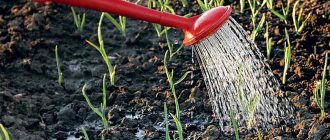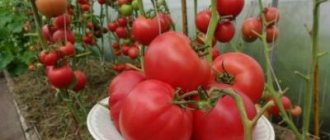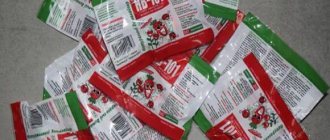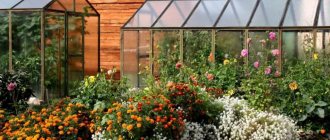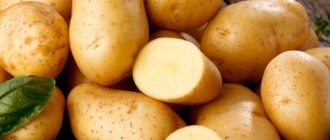Proper watering of tomatoes is the key to a good harvest. How often should you water tomatoes in a greenhouse and open ground? How much water is needed for irrigation. Is it possible to combine watering with fertilizing? We'll talk about all this in today's material.
Watering tomatoes is a simple matter. But there are a number of nuances. Especially progressive gardeners are experimenting, trying to do without water altogether. However, the technology for growing tomatoes without watering is quite controversial. As a rule, with insufficient moisture, plant leaves shrink and turn yellow. Not many people have the willpower to complete this experiment.
The ideal water temperature for irrigation is also a matter of debate. Most gardeners agree that watering tomatoes with cold water (below 15°C) is only permissible during the period of seedling hardening before planting in open ground.
Watering tomato seedlings
Before the seedlings sprout, the soil is sprayed with water once a day and covered with film. Subsequently, the film is removed and the seedlings are watered 1-2 times a week.
The optimal water temperature for tomato seedlings is 20-25°C. Some gardeners heat the water and then dilute it with colder water. But when water boils, it loses the oxygen needed by plants. Therefore, it is better to let the water stand in a warm place for some time to warm up to room temperature on its own.
- How to properly water seedlings on a windowsill, in a greenhouse and in the ground
Everything you wanted to know about watering vegetable seedlings.
Recommendations for gardeners
You should think about watering at the stage of planning the beds.
- It is necessary to take into account the location of the bed so that it is convenient to carry water or lay a hose.
- If you plan to irrigate by filling the beds, you need to plant the seedlings in 2 rows with a wide row spacing.
- At your summer cottage, prepare barrels to collect rainwater.
- If you have a water supply system, consider and prepare in advance a system for connecting and distributing water throughout the site.
- Prepare mulch (straw, wood chips, sawdust) for more comfortable growth of tomatoes. Using mulch reduces the risk of fungal diseases when the soil is waterlogged in rainy summers.
- In regions with traditionally rainy summers, it is recommended to grow tomatoes in high beds. They are prepared in advance, preferably in the fall.
The tomato harvest and its quality directly depend on the uniformity of the irrigation regime. There should be no overdrying of the soil followed by waterlogging. Such extreme conditions cause a response - the plants lose color and ovaries. Only following the rules guarantees a bountiful harvest.
Watering tomatoes during flowering
Tomatoes are watered exclusively at the root. This advice is especially relevant during the flowering period, since sprinkling causes buds to fall off and also delays fruit set. In addition, increased air humidity can cause the development of fungal diseases. During flowering, the amount of water is reduced to 1-2 liters per bush.
- Tomato diseases: 5 most common
How to cope with tomato diseases and prevent their occurrence in the future.
Favorable time for watering
The best time of day to irrigate tomatoes is early morning or late evening. If you water them in this way, the plants will be able to take full advantage of the moisture that flows to their roots. It is best to water early in the morning, 1-2 hours after the sun rises.
Evening watering can lead to waterlogging of the soil and the development of fungal diseases. If you water during the day, then a lot of water will simply evaporate and will not reach the tomatoes. In addition, during the day, when the sun shines intensely, plants increase the evaporation of moisture through the leaves, so it will leave in this way too.
In greenhouses, irrigating tomatoes during the day is even more unprofitable. As moisture evaporates, it enters the enclosed space, which greatly increases air humidity and increases the risk of disease. To reduce it, you will need to ventilate the greenhouse frequently. It is advisable to water tomato bushes at the root or in the grooves made nearby.
Sprinkling can also be used in open beds, but in a greenhouse it is still better to refrain from it, since droplets of water on tomato leaves can cause burns.
Watering tomatoes during fruiting
During the growth period of tomatoes, they are watered 1-2 times a week at the rate of 5-12 liters per square meter of bed or 3-5 liters per bush (depending on weather conditions and soil moisture). If you are late with the next watering and the soil is very dry, the amount of water should be reduced to 0.8-1 liters per bush. Otherwise, the fruit may begin to fall off or crack, and the plant will become especially vulnerable to blossom end rot.
- Secrets of large tomatoes
Growing tomatoes is one thing, but growing large tomatoes is a completely different matter. We'll show you how to achieve incredible results.
Features of caring for tomatoes after watering
To successfully grow a vegetable crop and harvest a large harvest, it is necessary to carry out various care measures. After watering the bushes, it is recommended to perform the following activities:
- Loosening the soil in the garden bed . Manipulation should be carried out 1-2 hours after adding moisture, when the water is completely absorbed. The procedure will prevent the formation of an earthen crust and improve the supply of oxygen to the root system of the plant, which will have a beneficial effect on the future harvest. You need to loosen shallowly, 2-3 centimeters is enough.
- Mulching. Mulch will slow down the evaporation of moisture and protect the root system from overheating. If you don’t want to loosen the soil in the garden bed every time after watering or rain, you can spread mulch on it in a layer of about 3-5 cm; you can use, for example, straw, hay, peat.
- Weed removal . The weeding procedure can be combined with loosening.
Watering tomatoes in a greenhouse
During fruit formation, tomato bushes are watered abundantly (20 liters per 1 sq.m.) as the soil dries. However, this increases the air humidity in the greenhouse, which is not very pleasant for the plants. Ventilation, as a rule, does not allow maintaining constant humidity at a level of 45-65%. In this case, you can use a drip irrigation system with a centralized water supply or using plastic bottles that feed each plant individually.
- Growing tomatoes in a greenhouse - the secrets of a bountiful harvest
Do you want to reap a rich harvest of delicious fruits? These rules of agricultural technology will help you with this!
Watering methods
It is well known that tomatoes love to be watered at the root. Drops of water falling on the leaves and stems turn into small lenses, and the sun's rays will cause burns. Damaged plants will become vulnerable to late blight and other fungal diseases. Each gardener chooses for himself the watering method that is more convenient for him.
Using bottles
This method is especially suitable for those who do not have the opportunity to come to their summer cottage every day.
The technique does not require special costs and is easy to implement. To implement your plan you will need:
- plastic bottles of suitable volume;
- old nylon tights;
- scissors;
- nail.
There should be as many bottles as there are tomato bushes you plant. The bottom of each container is cut off with scissors. Several holes are made in the lid with a hot nail, then the neck together with the lid is tied with nylon so that the holes made do not become clogged with earth.
If the soil is light and loose, you will need to make no more than 2-3 holes in each container. When using such a system on heavy clay soil, 4-5 holes will be needed.
After this, each bottle is dug halfway into the ground near the tomato bush at an angle of 35-40°. The slope should be towards the roots.
This procedure is carried out immediately after planting the seedlings in the garden bed, so as not to further damage the root system of the plants when burying the bottles. If irrigation installation work is carried out later, the containers are dug in to a shallower depth.
Now the gardener can only fill the bottles with water, which will gradually seep into the soil and water the plants. To reduce the evaporation of moisture from the containers themselves, the bottom can be cut off not completely and used as a lid.
Using this method, you get an individual watering system for each tomato bush.
You can bury bottles with the caps removed with the neck up. In this case, holes will have to be made in the walls and bottom of the containers. Usually they take large bottles (10 liters) and dig them in the middle between two bushes, and then both plants will receive water at once.
The only inconvenience of this method is that it will be inconvenient to pour water from a bucket through the narrow necks. The problem is solved by using a hose or funnel.
Drip irrigation
Drip irrigation of tomatoes has several advantages. This:
- minimizing labor costs;
- preservation of the structure of the top layer of soil;
- absence of increased air humidity due to evaporation.
Water enters directly into the soil, evenly saturating it with moisture, allowing you to avoid both waterlogging and dry soil.
The industrial drip irrigation system “Supertif” performed well.
- With its help, you can irrigate several beds with water at once.
- Droppers are inserted into hoses, on which even holes of the required size are first made.
When installing the system, it is necessary to check the connections for strength.
Together with the Supertif installation, the manufacturer supplies special supports for hoses. As a result, drip irrigation can be installed around the perimeter of the garden, ensuring the flow of water to the beds from 4 sides.
A summer resident can simply lay a hose with holes in the furrows made next to the tomatoes and carry out watering, connecting the hose to the container at the right time so that the water flows by gravity.
Semi-automatic drip irrigation in open ground - video
Automatic watering system
Automatic drip irrigation systems are even more convenient to use, but they are also the most expensive. The kit includes sprinklers and external nozzles. The systems themselves can be tape, push-button, or with built-in droppers.
Some craftsmen construct such devices on their own, but this requires special knowledge in creating such equipment and setting it up.
Droppers can be unregulated or adjustable. Using the last option, you can set economical water consumption.
A consultant will help you choose a suitable system, learn about its operating principle and installation features. The decision to purchase such expensive equipment must be made carefully.
Watering tomatoes in open ground
The rate of watering tomatoes in open ground depends on weather conditions. Both excessive and insufficient moisture are harmful to these plants. To prevent tomato leaves from turning yellow, it is necessary to water the bushes as the soil dries.
- Why do the leaves of tomatoes turn yellow in greenhouses and open ground?
A detailed description of the causes of yellow spots on tomato leaves and a guide to action.
On average, irrigation can be carried out 1-2 times a week. For one bush, 5 liters of water is usually enough.
To water tomatoes in open ground, you can use rainwater, since its degree of hardness, saturation with microelements and oxygen are optimal for plants. Of course, there are exceptions: for example, if you live near industrial enterprises or if you collect water from roofs whose materials contain copper, lead, asbestos and other substances that can have a negative impact on plant and human health. Under no circumstances should such water be used for irrigation.
- Rainwater collection is a real saving of effort, money and time
Rainwater is a renewable resource that many gardeners simply ignore. And completely in vain.
What kind of water do tomatoes like?
It is best to use rain water - it is softer than tap water and does not contain chlorine impurities. It is advisable to use distilled tap water because:
- chlorine reagents decompose and precipitate;
- excess calcium and phosphorus salts become insoluble;
- the water is warming up.
It is not advisable to use cold water so that the plant does not experience shock from the temperature contrast.
After work, the top layer of soil must be loosened. Using mulch on a tomato bed makes this operation unnecessary.
Drip irrigation of tomatoes
Drip irrigation is the most convenient soil irrigation technology, as water consumption is significantly reduced. At the same time, it is not wasted on the needs of weeds and does not end up on plant leaves, which reduces the risk of fungal diseases. It is especially convenient that along with drip irrigation you can organize root feeding.
- A few ideas on how to make drip irrigation at your dacha with your own hands
A drip irrigation system can be purchased at the store. But making it with your own hands is not much more difficult and much more interesting, and sometimes much cheaper.
What is the importance of proper watering of tomatoes?
Watering is of great importance for growing tomatoes, starting from the seed sowing stage. Without moistening the soil, the seeds will not be able to hatch and will not germinate. Young sprouts, along with moisture, also absorb nutrition from the soil - without this, seedlings will not be able to grow green mass.
The rate and method of watering are important, since a deficiency will lead to shedding of flowers and infantile formation of fruits. Excess water will cause root rot and lead to the death of the plant. It should be taken into account that a ripe fruit consists of 90% water. If the crop is not provided with adequate moisture, its pulp will be hard and tasteless.
Watering and fertilizing tomatoes
Many fertilizers, including organic ones, are quite aggressive and can burn fragile plant roots. Therefore, it is advisable to combine fertilizing with watering. And in some cases this is a prerequisite, for example, if you add bird droppings to the beds.
- Fertilize trees and shrubs with chicken droppings
Bird droppings are a valuable organic fertilizer. You just need to know exactly how, when and in what form to use it in the garden.
Watering tomatoes with iodine
Experienced gardeners believe that feeding tomatoes with iodine can speed up the ripening of fruits and protect plants from late blight. The simplest recipe is to dissolve 4 drops of an alcohol solution of iodine in 10 liters of water and water the tomatoes at a rate of no more than 2 liters per bush.
Also, in order to combat late blight, you can add 1 liter of skim milk and 15 drops of iodine to 10 liters of water and spray the plants with this solution no more than once every 2 weeks.
- Several folk ways of using iodine in the country
We'll tell you how to use iodine in your garden beds.
Watering tomatoes with yeast
You can feed tomatoes with yeast a week after transplanting into the ground. For this, 100 g of dry yeast and 2 tbsp. sugar is dissolved in 10 liters of warm (25-30°C) water. After two hours, this mixture is diluted with 50 liters of water and no more than 0.5 liters of solution is poured under one bush. Repeated feeding is carried out after the bush has rooted and before flowering.
- How to feed yeast to plants in the garden, vegetable garden and flower garden
Do you use yeast supplements? If not, we are ready to share with you interesting recipes and rates for applying this natural fertilizer.
Watering tomatoes with boric acid
Spraying with boric acid (5 g per 10 liters of water) can be useful for tomatoes if the flowers begin to fall off in hot weather. Also, foliar feeding using boric acid (2 g), manganese sulfate (4 g), copper sulfate (2 g) and zinc sulfate (2 g), diluted in 10 liters of water, can have a beneficial effect on the growth of tomatoes in a greenhouse. Do not fertilize during the day or in sunny weather - this can cause leaf burns.
- How to feed tomatoes that grow poorly
Have you noticed that your tomatoes have stopped growing? Perhaps they lack minerals and additional nutrition.
Watering tomatoes with mullein
Mullein is diluted with water in a ratio of 1:20 and the tomatoes are fed 10 days after planting in the ground. This organic fertilizer can be re-applied no earlier than after 10-14 days. You can also feed your green pets twice during the period of fruit formation. Under one bush, previously watered abundantly with water, add 0.5 liters of solution, after which the plants are watered again.
- Mullein is an indispensable fertilizer for the garden and vegetable garden.
It is difficult to find a more versatile and useful fertilizer than mullein. Read the article about how to prepare it and where to use it.
Watering tomatoes with ammonia
Ammonia is a nitrogenous compound that is sometimes used for root feeding and insect control. A pungent odor, which is not felt by humans after some time, repels pests for a long time.
Most often, 10 ml of ammonia is diluted in 1 bucket of water and the beds are watered up to 4 times for 2 weeks. When signs of nitrogen deficiency appear, seedlings are watered with a 2% ammonia solution in one of four regular waterings.
How to water tomatoes correctly
When watering, it is necessary to take into account the needs of a particular variety, the stage of development of tomatoes, weather conditions, and time of day. In addition, the water itself must be of a certain quality.
After planting the seedlings
The frequency of watering tomatoes after planting in the garden is directly related to the quality of the seedlings. Weak seedlings that require the creation of special conditions for adaptation will have to be protected with covering material for the first time. Bushes growing in shade do not evaporate moisture as intensively, so they require less frequent moistening.
Hardened, strong seedlings are watered once a week, spending up to 3 liters of water on each plant. If the soil dries out earlier, you can moisten the soil again. Immediately after planting, the bushes do not need watering. It is necessary to give the roots time to take root. Until this process is completed, the root system will not be able to fully absorb moisture. Therefore, the first watering of plants is carried out after 1.5-2 weeks.
On a note! Experts recommend combining the first watering after planting seedlings in the ground with preventive treatment against late blight, so instead of water it is better to use a weak solution of potassium permanganate.
Water temperature
Tomatoes do not like watering with cold, hard water; this can cause the plants to get sick. It is better to use warm rainwater collected in barrels for moisturizing, or at least settled from the water supply (you can soften it by adding a little compost or manure to the barrel).
In hot weather, the water temperature should not be lower than 18 degrees, and if it is cool outside, then the water should be another 2-4 degrees warmer. The optimal temperature for tomatoes is 24-26 degrees.
During the ripening period
When the bushes bloom, they need especially a lot of moisture, so water the plants once a week, adding 5 liters of water for each. Sprinkling is not used, as this will lead to shedding of flowers.
As soon as the tomatoes enter the fruiting phase, the volume of moisture applied is reduced to 1-1.5 liters of water per bush, and the interval between waterings is halved.
Neglecting this rule can cause cracking and shedding of fruits. For tall bushes, the watering rate is increased to 10 liters.
When is the best time to water?
Water open ground tomatoes in the early morning hours or 3-4 hours before sunset.
If you add moisture when the sun is shining actively, it will evaporate too quickly and the plants will not get anything. In cloudy weather, you can water the tomatoes whenever it is convenient for you; the time of watering in this case does not play a special role.
Is it possible in the heat
In hot weather, watering tomatoes is not only possible, but also necessary. Moreover, this has to be done more often than in normal weather.
The frequency of watering is increased to 4 times a week or more, focusing on the appearance of the soil and plants.
To prevent the added moisture from evaporating too quickly, it is recommended to mulch the soil with peat or compost. You can simply place cut grass at the base of the bushes. In addition, mulch will prevent the formation of a dense crust on the soil surface.
Watering tomatoes with ash
Wood ash contains about 30 minerals that contribute to the proper development of plants. These elements are involved in the process of photosynthesis, improve metabolic processes, help your green pets absorb vitamins and regulate water balance. Ash is added for digging when preparing a bed for tomatoes (3 cups per 1 sq.m.) or into holes when planting seedlings (a handful of ash in each hole). As an alternative, you can use ash infusion.
- Ash - what kind of fertilizer is it and how to use it correctly
Ash is not just a fireproof residue after combustion, but also a valuable microfertilizer. Our material contains everything about how ash is useful for plants, how to use ash as a fertilizer, how to dilute ash for feeding, what spraying with an ash solution is...
Watering tomatoes correctly, advice from experienced gardeners
Tomatoes are vegetables that are grown in almost every garden plot. To obtain good harvests, it is necessary to carry out the irrigation procedure correctly. However, not everyone knows how to “properly” water tomato plants growing in simple beds without shelter in order to harvest tasty and high-quality vegetables. This is exactly what the following article will talk about.
Adviсe
In conclusion, a few tips for successfully watering tomatoes:
- There are many factors in life that influence your daily routine: work, school, family problems, so it is not always possible to water in the morning. We then advise you to plan irrigation for the weekend. If the weather is hot, then an additional procedure in the middle of the week after sunset is quite suitable.
- Water for irrigation should be warm, so keep containers with irrigation liquid in the greenhouse. It is better to fill the bottles 12-14 hours in advance so that everything has time to warm up.
- Late blight is a disease that affects tomatoes when the air in the greenhouse is too humid. Do regular ventilation when watering; in hot weather, we advise you to always keep the greenhouse door open.
- If a crust has formed, it must be loosened and irrigated.
- Once every 2-3 weeks, mineral fertilizers are added to the water.
The liquid should penetrate deep into the soil, to a distance of up to 20 cm.
When to water?
When and how often to water tomatoes in a greenhouse? Gardeners do not have a unanimous opinion on this issue, but it is still recommended to focus on weather conditions and the structural features of your greenhouse.
If the weather outside is warm and dry , then watering time does not matter. Especially if you do it carefully and the possibility of sunburn of the leaves is excluded. It is better to water in the afternoon , since the water is already quite warm by this hour, whereas in the morning it is still cool.
Watering late in the evening is also not recommended . Because a greenhouse closed at night creates excess air humidity, and this is harmful for tomatoes.
If watering is carried out in the evening , long-term ventilation of the greenhouse is required after it so that excess moisture evaporates and the tomatoes remain healthy.
In damp and cool weather , it is better to water the tomatoes before noon, so that the space is well ventilated during the day and excess moisture evaporates from the air.
IMPORTANT. No matter what time you perform the procedure. Leave the windows and doors open after it. If you close the greenhouse immediately after watering, the excess moisture in the air will encourage the development of fungus.
Proper organization of watering tomatoes when growing them in a greenhouse will allow you to get a large harvest of healthy and tasty fruits.
Basic Rules
The effectiveness of irrigation depends on several factors. One of them is the type of watering - at the root. This is done in order to saturate the plant with the necessary moisture and at the same time maintain air humidity at the desired level. You can also water in furrows, as long as drops of water do not fall on the stems and leaves of the tomato. If they fall on the leaves, the drops turn into lenses through which the tomato will get burned in the sun. This in turn will only accelerate the development of late blight.
As for air humidity, when watering at the root, it will be maintained at the required level, which will prevent fungal diseases from developing.
The sprinkling method, actively practiced by gardeners, will not work here, since it will not have the best effect on the growth and development of tomatoes.
Photo gallery of rules for watering tomatoes
Do not hose
Water with settled warm water
Don't water the leaves
In order for tomatoes to grow properly and without diseases, you need to water them with settled warm water, which should be approximately equal to the temperature of the soil. Typically this value varies between 24-26 degrees. Trying to water tomatoes with a hose leads to a drop in soil temperature, disruption of the acid balance and damage to the roots. The best option is to water with rainwater, which contains carbonic acid. This has a softening effect, unlike tap water, which is excessively hard. If there is no alternative, mix it with some manure, compost and weeds to soften it.
The weather directly affects the time of watering plants. In bright sunshine, it is better to wait until the evening and water a few hours before sunset. Over the rest of the evening and night, the water will be well absorbed and will be absorbed by the plants. In cloudy weather, watering time does not matter.
Mulching will help retain moisture for as long as possible. As a mulching material, you can choose either special films like spunbond or organic residues. So straw, collected weeds and compost, laid on top of the bed in a layer of five centimeters, will significantly retain moisture in the top layer of soil and allow it to maintain looseness, while simultaneously reducing the number of growing weeds. In addition, this composition will begin to decompose over time and provide the soil with all the necessary nutrients.
Mulch in the form of straw helps retain moisture in the top layer of soil longer
Features of the microclimate of greenhouses
Before determining how often and correctly to water tomatoes in a greenhouse, let’s look at the features of the microclimate created inside greenhouses.
Air humidity in summer is approximately 60-80% . The exception is too hot and dry periods, when humidity drops to 40% . In this case, hot weather can alternate with rain, and then the humidity reaches 90% .
If watering in a greenhouse is improper, these indicators can be even higher, and this is detrimental to tomatoes. A feature of this crop is its requirement for moisture in the soil , but it prefers dry air for the successful development of the above-ground part. These are the conditions that need to be provided to tomatoes in the greenhouse with proper watering.
Both too much and too little watering are harmful to tomatoes . If there is too much moisture in the soil, the roots are unable to absorb it and begin to rot. Lack of moisture leads to active dehydration of foliage, and plants can overheat and die.
IMPORTANT. If you notice that the tomato leaves have begun to curl along the central vein, it means they lack moisture.
Types of irrigation organization
How to water tomatoes in a greenhouse? There are several ways to organize watering tomatoes in a greenhouse:
Manual
This method is most suitable for small buildings . Using simple devices - watering cans or hoses - water is poured strictly to the root .
When watering with a hose, water often comes from a well and a water supply system, so there is a danger of hypothermia of the roots . The disadvantage of watering with a hose is the inability to control the amount of liquid per plant.
It is more advisable to organize manual watering from a watering can with settled water . To do this, it is better to place a barrel next to the greenhouse, which is filled with water in advance to heat it.
ATTENTION. If a barrel of water is placed directly in the greenhouse, be sure to cover it with a lid or plastic wrap. An open container of water in a greenhouse creates excessive air humidity, which is harmful for tomatoes.
Drip
Its organization is effective in large greenhouses , since manual watering in this case requires a lot of time and effort. It is better to simplify it by building a drip irrigation system in the greenhouse. The advantages of such irrigation are obvious:
- water goes directly to the roots without evaporating from the surface and without increasing air humidity;
- eliminates the risk of water droplets getting on the leaves, stems and flowers of plants;
- watering can be carried out at any convenient time;
- the soil is not washed away and does not become salty.
In order to organize drip irrigation of tomatoes, a special system is installed in the greenhouse to ensure the flow of moisture through special pipes to the roots . Such a system can be purchased ready-made in specialized stores or installed independently. The advantage of such watering is the additional possibility of fertilizing plants.
If it is not possible to build a drip irrigation system, you can use a very original and simple method - drip watering tomatoes in a greenhouse using plastic bottles. To do this, bottles with holes are dug into the ground next to the tomato bushes with their necks upside down. Water is poured into a bottle and gradually flows through small holes to the roots. Since one tomato plant in a greenhouse requires up to 5 liters per watering, it is better to use plastic bottles of the appropriate size.
Another option for homemade drip irrigation is to dig a tube into the ground, onto which the bottle is placed upside down. A hole is made in the bottom to fill in water. The filled bottle gradually delivers water through the tube to the roots.
Auto
Most often, this method is used in industrial greenhouses , since at the household level its cost is too high. But if the owner can afford such a structure on his site, then its use is most optimal .
Features of watering tomatoes depending on the type of their growth (determinant and indeterminate)
Due to the different lengths of the growing season, watering determinate and indeterminate tomatoes is slightly different. So, when growing low-growing varieties in open ground, the watering rate after the formation of ovaries is noticeably reduced, and before harvesting it is stopped completely. Due to the fact that the fruits of such tomatoes ripen almost simultaneously, the plant no longer needs an increased amount of moisture. If you continue to water the plantings in the same mode as before, this will lead to cracking of the fruits and make them watery. In addition, excess moisture increases the risk of fungal diseases such as late blight.
With tall tomatoes the situation is different. The load on indeterminate plants from the moment they begin to bear fruit is very large, since several processes occur simultaneously: vine growth, flowering, ovary formation and fruit filling. Accordingly, the need for moisture is very high. Therefore, during active fruiting, watering is carried out once every four days, and the consumption is about one bucket of water per bush.
Watering during growth and fruiting
The growing season of tomatoes is divided into several stages:
- Development and growth of seedlings.
- Adaptation to a new place after planting in open ground or in a greenhouse.
- Growth and development before flowering.
- Bloom.
- Formation of fruit ovaries.
- Fruiting.
At each stage of growth, tomatoes require watering, but the amount of water and frequency at each stage varies:
- Having planted tomato seedlings in open ground and watered them for the first time, you should take a significant break of 10-14 days, allow the tomatoes to get used to the new conditions without disturbing their natural course;
- watering should be resumed when it becomes noticeable that the plant has taken root and started to grow; at this time and before flowering, the tomatoes are watered frequently (see the section “Wiring regime” below);
- with the beginning of flowering, watering is done less frequently, but the amount of water is increased;
- during fruit set, the volume of water is increased even more with each watering, the frequency is the same as during flowering;
- when the tomato fruits begin to fill up, turning slightly brown, the number of waterings is reduced, the amount of water is reduced, this regime is maintained for the entire fruiting period.
Regulating the frequency of watering and the volume of water is necessary to maintain the plant’s water balance. During active growth, tomatoes absorb significantly more water to increase green mass and form stems. Moderate watering during the fruiting period is necessary to ensure that tomato fruits do not crack and retain more nutrients.
Attention! The taste of tomatoes improves from increased sugar content; the higher the level, the sweeter the fruit. The Cherry tomato variety, for example, is rich in sugars, so the tomatoes are very sweet. Reducing watering during the ripening period of tomatoes contributes to the accumulation of not only sugar, but also other useful substances in the fruit.
